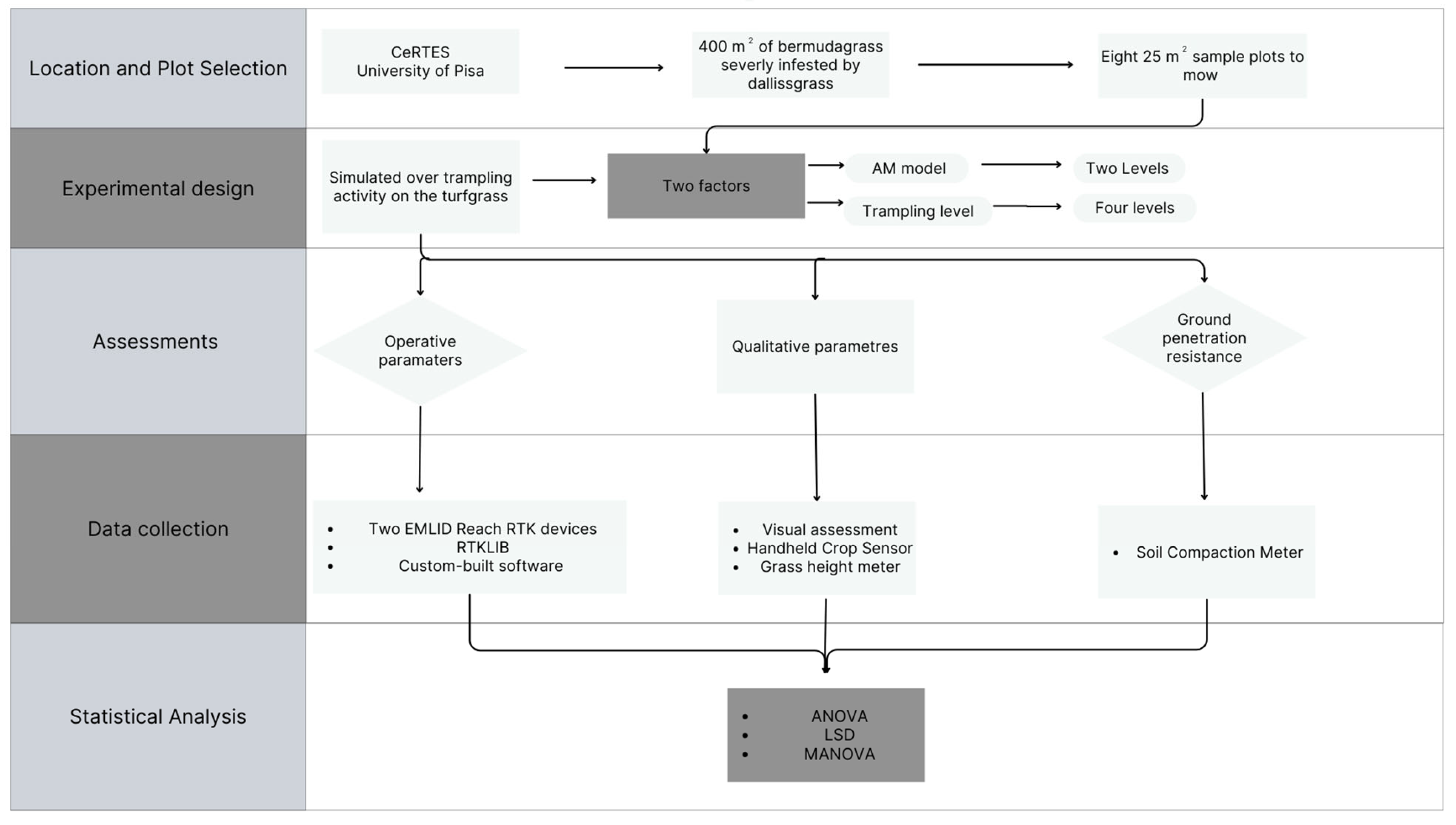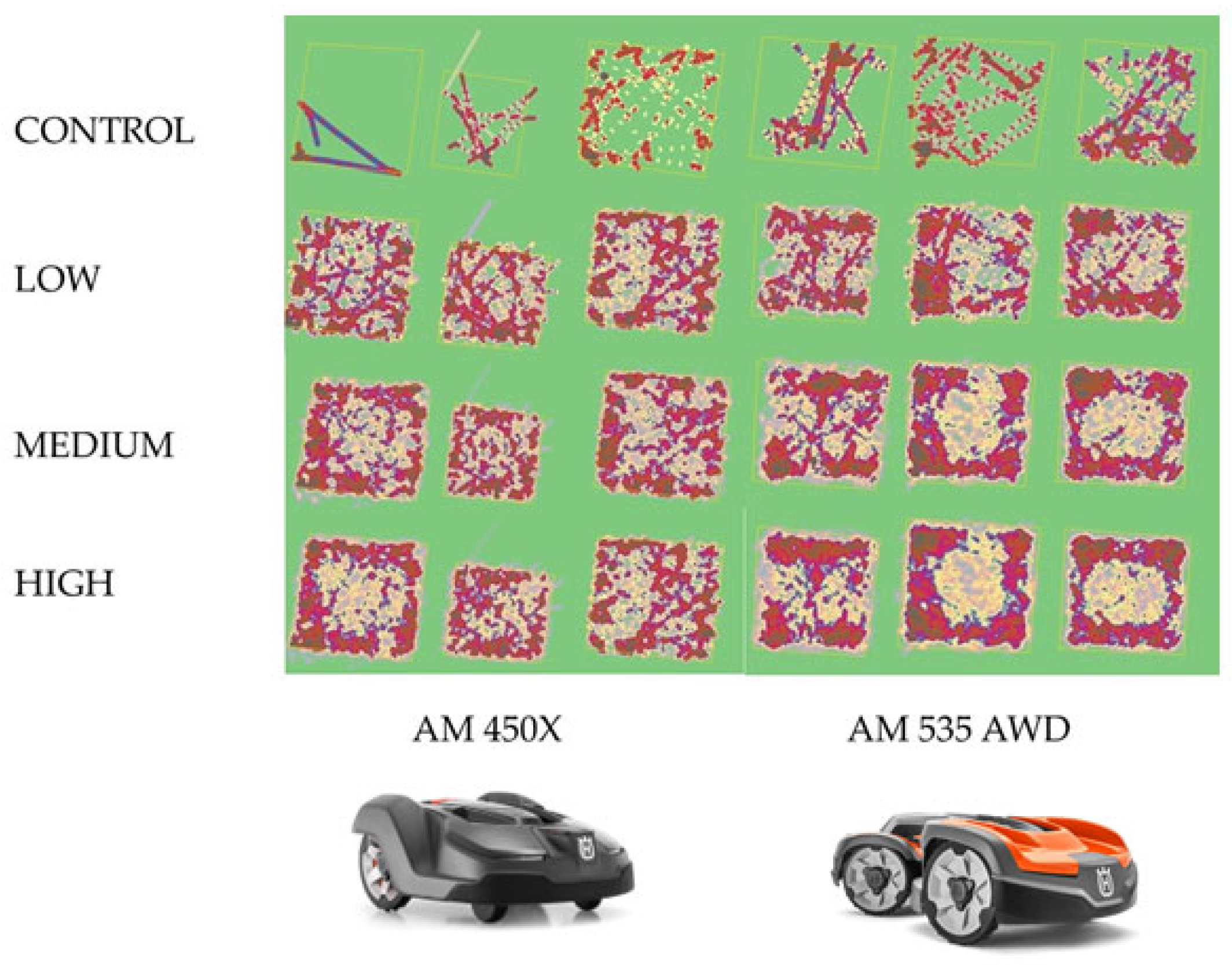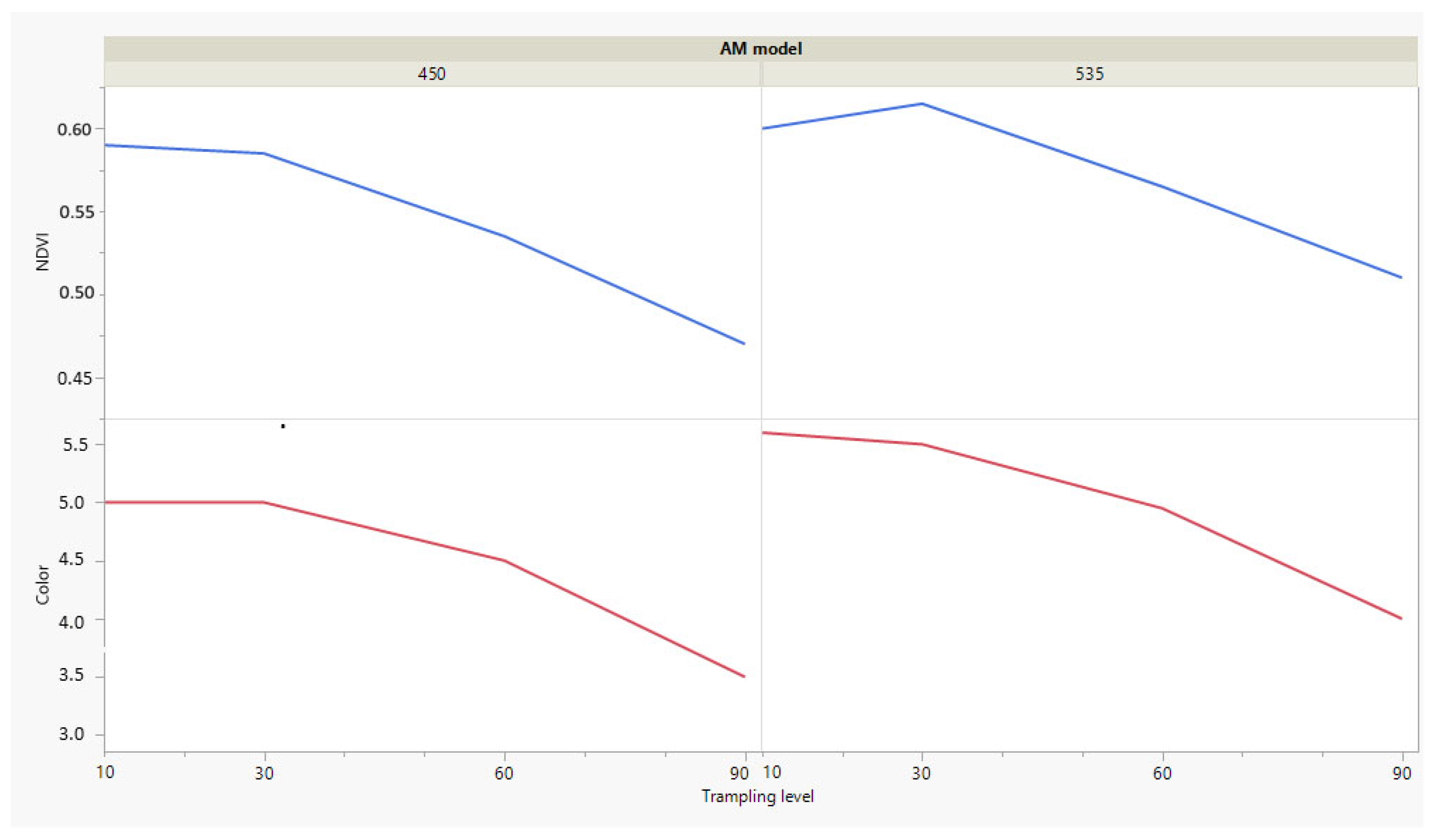Monitoring Autonomous Mowers Operative Parameters on Low-Maintenance Warm-Season Turfgrass
Abstract
:1. Introduction
2. Materials and Methods
2.1. Experimental Field Trials
2.2. Assessments
2.3. Statistical Analysis
3. Results
3.1. Operative Parameters Analysis
3.2. Qualitative Parameters Analysis
3.3. Soil Penetration Resistance Analysis
4. Discussion
4.1. Autonomous Mowers Performances
4.2. Autonomous Mowers Activity Effects on Turfgrass Quality Parameters
5. Conclusions
- -
- enhancement of AMs positioning accuracy testing and comparing different positioning systems;
- -
- the selection of local species suitable for turfgrass mowed by AMs;
- -
- further tests may be conducted at different times of the year (ideally in the late spring) to confirm any results from the instrumental analysis that are more visible and realistic;
- -
- more extended studies on biological parameters through different vegetation indices;
- -
- testing other responses to the same trampling levels using autonomous mowers with a systematic pattern, which may produce more accurate trampling values.
Author Contributions
Funding
Institutional Review Board Statement
Informed Consent Statement
Data Availability Statement
Acknowledgments
Conflicts of Interest
References
- Pantaloni, M.; Marinelli, G.; Santilocchi, R.; Minelli, A.; Neri, D. Sustainable Management Practices for Urban Green Spaces to Support Green Infrastructure: An Italian Case Study. Sustainability 2022, 14, 4243. [Google Scholar] [CrossRef]
- Mcelroy, S.; Magni, S.; Caturegli, L.; Sportelli, M.; Sciusco, G.; Fontanelli, M.; Volterrani, M. Autonomous Mowers Will Change the Rules of Mowing. Golf Course Manag. Online. 2022. Available online: https://gcmonline.com/course/environment/news/autonomous-mowers (accessed on 26 June 2023).
- Staněk, L.; Krajíček, T.; Dvořák, T. Suitability of Using Mechanization Means for the Maintenance of Grass Stands by the Method of Mulching. Acta Univ. Agric. Et Silvic. Mendel. Brun. 2022, 70, 83–95. [Google Scholar] [CrossRef]
- Owen, M.C.; Lanier, J.D. Best Management Practices for Lawn and Landscape Turf, Version 1.51; Umass Extension: BMPs for Lawn Landscape Turf. 2016. Available online: http://extension.umass.edu/turf (accessed on 26 June 2023).
- Hicks, R.W.; Hall, E.L. A Survey of Robot Lawn Mowers. In Proceedings of the Intelligent Systems and Smart Manufacturing, Boston, MA, USA, 5–8 November 2000. [Google Scholar] [CrossRef]
- Yue, C.; Wang, J.; Watkins, E.; Bonos, S.A.; Nelson, K.C.; Murphy, J.A.; Meyer, W.A.; Horgan, B.P. Heterogeneous Consumer Preferences for Turfgrass Attributes in the United States and Canada. Can. J. Agric. Econ. 2017, 65, 347–383. [Google Scholar] [CrossRef]
- Spykman, O.; Gabriel, A.; Ptacek, M.; Gandorfer, M. Farmers’ perspectives on field crop robots—Evidence from Bavaria, Germany. Comput. Electron. Agric. 2021, 186, 106176. [Google Scholar] [CrossRef]
- Diwakaran, S.; Kumar, M.D.V.; Mohanreddy, P.S.; Rishika, C.; Sreenivasulu, P.; Sivasubramanian, M. Design of an Autonomous Mower with Height Adjustable Cutting Motor. In Proceedings of the ICSPC 2023—4th International Conference on Signal Processing and Communication, Coimbatore, India, 23–24 March 2023; pp. 348–352. [Google Scholar] [CrossRef]
- Huang, X.; Yi, J.; Shen, T. Research on automatic lawn mower system based on differential GPS and IMU fusion. In Proceedings of the 2023 3rd Asia-Pacific Conference on Communications Technology and Computer Science (ACCTCS), Shenyang, China, 25–27 February 2023; pp. 426–432. [Google Scholar] [CrossRef]
- Gagliardi, L.; Sportelli, M.; Frasconi, C.; Pirchio, M.; Peruzzi, A.; Raffaelli, M.; Fontanelli, M. Evaluation of autonomous mowers weed control effect in globe artichoke field. Appl. Sci. 2021, 11, 1658. [Google Scholar] [CrossRef]
- Sportelli, M.; Luglio, S.M.; Caturegli, L.; Pirchio, M.; Magni, S.; Volterrani, M.; Frasconi, C.; Raffaelli, M.; Peruzzi, A.; Gagliardi, L.; et al. Trampling Analysis of Autonomous Mowers: Implications on Garden Designs. AgriEngineering 2022, 4, 592–605. [Google Scholar] [CrossRef]
- Martelloni, L.; Fontanelli, M.; Pieri, S.; Frasconi, C.; Caturegli, L.; Gaetani, M.; Grossi, N.; Magni, S.; Pirchio, M.; Raffaelli, M.; et al. Assessment of the cutting performance of a robot mower using custom built software. Agronomy 2019, 9, 230. [Google Scholar] [CrossRef] [Green Version]
- Sportelli, M.; Fontanelli, M.; Pirchio, M.; Frasconi, C.; Raffaelli, M.; Caturegli, L.; Magni, S.; Volterrani, M.; Peruzzi, A. Robotic mowing of tall fescue at 90 mm cutting height: Random trajectories vs. systematic trajectories. Agronomy 2021, 11, 2567. [Google Scholar] [CrossRef]
- Qiang, X.; Jun, Q.; Yong-hong, H. Effects of different trampling intensities on three species of warm season turfgrass. Acta Prataculturae Sin. 2022, 31, 52–61. [Google Scholar] [CrossRef]
- Carrow, R.N.; Petrovic, A.M. Effects of traffic on turfgrass. In Turfgrass Agronomy Monograph 32; Waddington, D.V., Carrow, R.N., Shearman, R.C., Eds.; ASA, CSSA, and SSSA: Madison, WI, USA, 1992; pp. 285–330. [Google Scholar]
- Sportelli, M.; Martelloni, L.; Orlandi, A.; Pirchio, M.; Fontanelli, M.; Frasconi, C.; Raffaelli, M.; Peruzzi, A.; Consorti, S.B.; Vernieri, P. Autonomous mower management systems efficiency improvement: Analysis of greenspace features and planning suggestions. Agriculture 2019, 9, 115. [Google Scholar] [CrossRef] [Green Version]
- Pirchio, M.; Fontanelli, M.; Frasconi, C.; Martelloni, L.; Raffaelli, M.; Peruzzi, A.; Gaetani, M.; Magni, S.; Caturegli, L.; Volterrani, M.; et al. Autonomous Mower vs. Rotary Mower: Effects on turf quality and weed control in tall fescue lawn. Agronomy 2018, 8, 15. [Google Scholar] [CrossRef] [Green Version]
- Morris, K.N.; Shearman, R.C. NTEP Turfgrass Evaluation Guidelines. 2008. Available online: https://www.ntep.org/pdf/ratings.pdf (accessed on 26 June 2023).
- Caturegli, L.; Gaetani, M.; Volterrani, M.; Magni, S.; Minelli, A.; Baldi, A.; Brandani, G.; Mancini, M.; Lenzi, A.; Orlandini, S.; et al. Normalized Difference Vegetation Index versus Dark Green Colour Index to estimate nitrogen status on bermudagrass hybrid and tall fescue. Int. J. Remote Sens. 2020, 41, 455–470. [Google Scholar] [CrossRef]
- Bosse, M.; Nourani-Vatani, N.; Roberts, J. Coverage Algorithms for an Under-actuated Car-Like Vehicle in an Uncertain Environment. In Proceedings of the IEEE International Conference on Robotics and Automation, Roma, Italy, 10–14 April 2007; pp. 698–703. [Google Scholar]
- Monteiro, J.A. Ecosystem services from turfgrass landscapes. Urban For. Urban Green. 2017, 26, 151–157. [Google Scholar] [CrossRef]
- Ignatieva, M.; Haase, D.; Dushkova, D.; Haase, A. Lawns in cities: From a globalised urban green space phenomenon to sustainable nature-based solutions. Land 2020, 9, 73. [Google Scholar] [CrossRef] [Green Version]
- Beard, J.B.; Green, R.L. The Role of Turfgrasses in Environmental Protection and Their Benefits to Humans. J. Environ. Qual. 1994, 23, 452–460. [Google Scholar] [CrossRef] [Green Version]
- MacLaren, C.; Swanepoel, P.; Bennett, J.; Wright, J.; Dehnen-Schmutz, K. Cover crop biomass production is more important than diversity for weed suppression. Crop Sci. 2019, 59, 733–748. [Google Scholar] [CrossRef] [Green Version]
- Grossi, N.; Volterrani, M.; Magni, S. Tall Fescue Turf Quality and Soccer Playing Characteristics as Affected by Mowing Height. In Proceedings of the International Conference on Turfgrass Management and Science for Sports Fields, Athens, Greece, 2–7 June 2003; pp. 319–322. [Google Scholar]
- Yousfi, S.; Marín, J.; Parra, L.; Lloret, J.; Mauri, P.V. Remote sensing devices as key methods in the advanced turfgrass phenotyping under different water regimes. Agric. Water Manag. 2022, 266, 107581. [Google Scholar] [CrossRef]
- Krans, J.V.; Beard, J.B. Effects of Clipping on Growth and Physiology of ‘Merion’ Kentucky Bluegrass. Crop Sci. 1985, 25, 17–20. [Google Scholar] [CrossRef]
- Pornaro, C.; Novello, A.; Fidanza, M.; Macolino, S. Grasscycling: A Key Practice for Sustainable Turfgrass Management. Grasses 2022, 1, 45–52. [Google Scholar] [CrossRef]
- Schiavon, M.; Pornaro, C.; Macolino, S. Clippings return decreases mineral nitrogen requirements for bermudagrass (Cynodon spp.) lawns in Mediterranean Europe. Crop Sci. 2021, 61, 2916–2925. [Google Scholar] [CrossRef]






| Year | Month | Average Temperature (°C) | Precipitation (Days) | Humidity (%) | |
|---|---|---|---|---|---|
| Max | Min | ||||
| 2021 | September | 22 | 7 | 73.9 | |
| 27.4 | 16.9 | ||||
| October | 16.3 | 5 | 68.9 | ||
| 22 | 11.5 | ||||
| Parameter | Unit | Autonomous Mowers | |
|---|---|---|---|
| Automower 450X | Automower 535 AWD | ||
| Dimension (Length × Height × Width) | cm | 72 × 31 × 56 | 93 × 29 × 55 |
| Mass | kg | 13.9 | 17 |
| Cutting height | cm | 3.5 | 3.5 |
| Hourly work capacity * | m2/h | 208 | 146 |
| Hourly electric energy consumption | kWh/h | 0.028 | 0.032 |
| Source | Distance Traveled | Area Mowed | Intersections | Work Efficiency |
|---|---|---|---|---|
| AM model | *** | NS | * | *** |
| Trampling level | *** | *** | *** | *** |
| AM model × Trampling level | NS | NS | * | *** |
| Source | Passages | Height |
|---|---|---|
| AM model | . | NS |
| Trampling level (TL) | *** | *** |
| Position | *** | *** |
| Trampling level × Position | ** | *** |
| AM model × Trampling level | *** | *** |
| AM model × Position | NS | NS |
| AM model × Position × TL | NS | ** |
| AM Model | Trampling Level | Electric Energy Consumption (kWh) |
|---|---|---|
| 535 AWD | Control | 0.0053 |
| Low | 0.0160 | |
| Medium | 0.0320 | |
| High | 0.0480 | |
| 450X | Control | 0.0047 |
| Low | 0.0140 | |
| Medium | 0.0280 | |
| High | 0.0420 |
| Source | Color | Quality | NDVI |
|---|---|---|---|
| AM model | *** | *** | *** |
| Trampling level | *** | *** | *** |
| AM model × Trampling level | *** | *** | * |
| AM Model | Trampling Level | Color (1–9 Visual Scale) | Quality (1–9 Visual Scale) | NDVI |
|---|---|---|---|---|
| 535 AWD | Control | 5.60 a | 5.60 a | 0.60 ab |
| Low | 5.50 a | 5.50 b | 0.61 a | |
| Medium | 4.95 ab | 5.00 c | 0.56 abc | |
| High | 4.00 bc | 5.00 c | 0.51 cd | |
| 450X | Control | 5.00 ab | 5.00 c | 0.59 ab |
| Low | 5.00 ab | 5.00 c | 0.58 abc | |
| Medium | 4.50 abc | 4.50 d | 0.53 bcd | |
| High | 3.50 c | 4.50 d | 0.47 d | |
| LSD: 1.103 | LSD: 0.467 | LSD: 0.079 |
| Source | Depth (cm) | Mean Square | F | p |
|---|---|---|---|---|
| AM model | 0.0 | 224,653.500 | 12.75 | 0.001 |
| 2.5 | 469,653.630 | 19.93 | 6.4 × 10−5 | |
| 5.0 | 234037.500 | 10.04 | 0.003 | |
| 7.5 | 306,757.407 | 5.268 | 0.027 | |
| 10.0 | 127,506.963 | 1.378 | 0.247 | |
| Trampling level | 0.0 | 2702.796 | 0.153 | 0.858 |
| 2.5 | 3573.722 | 0.152 | 0.860 | |
| 5.0 | 7348.463 | 0.315 | 0.731 | |
| 7.5 | 37,698.296 | 0.647 | 0.529 | |
| 10.0 | 269,929.056 | 2.917 | 0.066 | |
| Trampling level × AM model | 0.0 | 1316.056 | 0.075 | 0.928 |
| 2.5 | 13,283.019 | 0.564 | 0.574 | |
| 5.0 | 19,564.389 | 0.839 | 0.440 | |
| 7.5 | 59,990.519 | 1.030 | 0.366 | |
| 10.0 | 159,303.463 | 1.722 | 0.192 |
| Depth (cm) | AM Model | Mean (kPa) | Std. Error | 95% Confidence Interval | |
|---|---|---|---|---|---|
| Lower Limit | Upper Limit | ||||
| 0.0 | 450X | 394.741 | 25.543 | 343.116 | 446.365 |
| 535 AWD | 523.741 | 25.543 | 472.116 | 575.365 | |
| 2.5 | 450X | 618.519 | 29.543 | 558.809 | 678.228 |
| 535 AWD | 805.037 | 29.543 | 745.328 | 864.746 | |
| 5.0 | 450X | 670.815 | 29.378 | 611.422 | 730.208 |
| 535 AWD | 802.481 | 29.378 | 743.089 | 861.874 | |
| 7.5 | 450X | 835.704 | 46.441 | 741.843 | 929.565 |
| 535 AWD | 986.444 | 46.441 | 892.583 | 1080.306 | |
| 10 | 450X | 1055.407 | 58.543 | 937.088 | 1173.727 |
| 535 AWD | 1152.593 | 58.543 | 1034.273 | 1270.912 | |
Disclaimer/Publisher’s Note: The statements, opinions and data contained in all publications are solely those of the individual author(s) and contributor(s) and not of MDPI and/or the editor(s). MDPI and/or the editor(s) disclaim responsibility for any injury to people or property resulting from any ideas, methods, instructions or products referred to in the content. |
© 2023 by the authors. Licensee MDPI, Basel, Switzerland. This article is an open access article distributed under the terms and conditions of the Creative Commons Attribution (CC BY) license (https://creativecommons.org/licenses/by/4.0/).
Share and Cite
Luglio, S.M.; Sportelli, M.; Frasconi, C.; Raffaelli, M.; Gagliardi, L.; Peruzzi, A.; Fortini, V.; Volterrani, M.; Magni, S.; Caturegli, L.; et al. Monitoring Autonomous Mowers Operative Parameters on Low-Maintenance Warm-Season Turfgrass. Appl. Sci. 2023, 13, 7852. https://doi.org/10.3390/app13137852
Luglio SM, Sportelli M, Frasconi C, Raffaelli M, Gagliardi L, Peruzzi A, Fortini V, Volterrani M, Magni S, Caturegli L, et al. Monitoring Autonomous Mowers Operative Parameters on Low-Maintenance Warm-Season Turfgrass. Applied Sciences. 2023; 13(13):7852. https://doi.org/10.3390/app13137852
Chicago/Turabian StyleLuglio, Sofia Matilde, Mino Sportelli, Christian Frasconi, Michele Raffaelli, Lorenzo Gagliardi, Andrea Peruzzi, Veronica Fortini, Marco Volterrani, Simone Magni, Lisa Caturegli, and et al. 2023. "Monitoring Autonomous Mowers Operative Parameters on Low-Maintenance Warm-Season Turfgrass" Applied Sciences 13, no. 13: 7852. https://doi.org/10.3390/app13137852
APA StyleLuglio, S. M., Sportelli, M., Frasconi, C., Raffaelli, M., Gagliardi, L., Peruzzi, A., Fortini, V., Volterrani, M., Magni, S., Caturegli, L., Sciusco, G., & Fontanelli, M. (2023). Monitoring Autonomous Mowers Operative Parameters on Low-Maintenance Warm-Season Turfgrass. Applied Sciences, 13(13), 7852. https://doi.org/10.3390/app13137852











